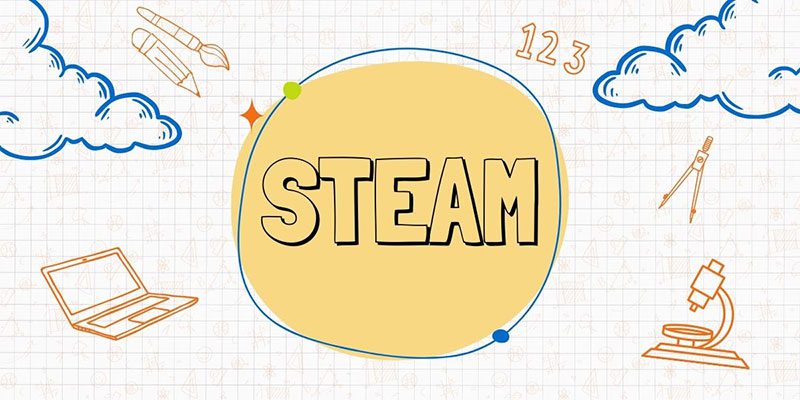By Children’s Librarian Eileen Saam
At the Oak Park Public Library, we are always looking for ways to foster learning experiences for the children who we serve. We have done lots of research into ways that we can emphasize STEAM learning in the resources that we offer our young patrons.
In particular, we have developed a sizable collection of Discovery Kits, which are filled with everything you need to foster the kinds of exploratory, hands-on experiences that are inherent in STEAM learning. See the STEAM and technology kits you can check out from the library below!
But what is STEAM Learning? The acronym stands for Science, Technology, Engineering, Arts, and Mathematics. This interdisciplinary approach to learning integrates all five of these disciplines. Learn more about the history of STEAM (and STEM) learning and the benefits of this approach to learning below!
You might be wondering…why the focus on STEAM Learning?
STEAM learning helps students…
- Get excited about learning.
- Embrace creativity.
- Foster a passion for inquiry and innovation.
- Develop and practice skills for the 21st century.
- Flourish in a tech-driven environment.
STEAM learning allows kids the opportunity to make connections and discover new things through exploration, inquiry, and problem solving, the way one would in real life. They learn the value of the principles of teamwork and the importance of applying ingenuity, critical thinking skills, and creativity to solving problems. They learn that mistakes are an integral part of the learning process.
How do Discovery Kits foster STEAM learning?
Let’s say you take home the Botley robot kit and are learning how to code Botley with the controller to move where you want it to move.
After building a course with the parts in the kit, you might be inspired to add additional components to your course for your robot to follow. This might mean you’ll need to do some measuring to figure out how long and wide it should be.
After experimenting with the Botley robot on the course, you might be inspired to add some lights, which may lead to experimenting with LED lights and circuits. This might mean that you’ll want to check out our snap circuits kit from the library! Do you see where I’m going with this?
Want to give it a try at home? Check out these Discovery Kits…
New Discovery Kits designed to integrate STEAM learning & exploration
Botley
Coding is the language we use to communicate with computers. In this kit, kids have the opportunity to use coding language and coding principles to program Botley the robot to “think” using a remote programmer and coding cards as a guide. This Discovery Kit helps teach and encourage many skills inherent in STEAM learning.
Spero Specdrums
In this kit, kids can connect to the spectrums app and make music with two specdrum rings, play on the colored playing pad and on surfaces around them, while experimenting with sounds, rhythms, and tempo. Specdrums is a unique and hands-on way to integrate music and strengthen computational thinking, creativity, and problem-solving skills.
Sphero Mini
With this Sphero mini robot kit, beginning coders have the opportunity to drive and play STEM-inspired games with the Sphero Play app. More experienced learners can program the Sphero robot using block-based coding or javascript in the Sphero Edu app. Kids can take their learning to the next level and build their own mazes, obstacles, towers, and tracks to navigate through the house!
More technology Discovery Kits
Van de Graaff Generator
Kids can explore the principles of electrostatics with this kit. To understand what a Van de Graaff Generator is and how to use it, read this interactive tutorial from nationalmaglab.org.
Windmill Generator
Kids can explore how wind is harnessed to power an LED bulb.
We hope these kits spark joy, inspiration, collaboration & creative exploration!
At your public library, we value all types of learning. We love when patrons are inspired by the resources in our library to take their learning to the next level.
If you are inspired to share what you have created, please do so. We’d love to know how you took your learning to the next level!
And if you are inspired to learn more about careers in STEM, check out this video: STEM Careers: Inspire the Next Generation of Innovators.
About STEM & STEAM
What’s the deal with STEM?
You have probably seen this term everywhere! The acronym stands for Science, Technology, Engineering, and Mathematics.
An interdisciplinary approach to learning, STEM learning does not simply mean learning about science, technology, engineering, and mathematics. Rather, it emphasizes an educational philosophy that integrates these disciplines.
And what about STEAM?
In 2006, education researcher, Georgette Yakman, added Art to STEM to make STEAM: Science, Technology, Engineering, Art, and Mathematics. Based on Yakman’s experience in education, she believed it was important to incorporate the ideas of creativity and innovation in the Arts into STEM education. Since then STEAM has gained a lot of attention!
The arts discipline adds the study of the humanities, language arts, dance, drama, music, visual arts, design, new media, and more. By integrating the arts into STEM, an emphasis is placed on teamwork, cooperation, creativity, and adaptation.
To learn more about the philosophy of STEAM education, check out this video from STEAMspirations: What is STEAM Education? A STEAMspired approach to STEAM!

About Eileen
Eileen Saam is a children’s digital learning librarian who loves discovering new things, learning from others, and sharing with children the joy and wonder of books. One of her favorite things to do at the library is to help children, families, and teachers find books and digital resources that delight and inspire them.

